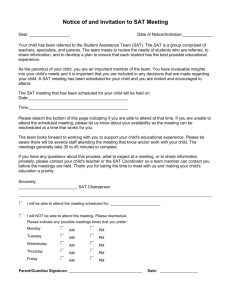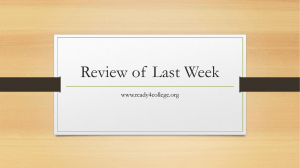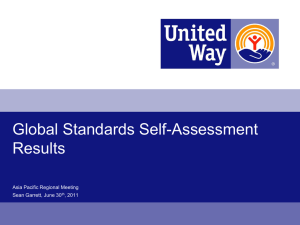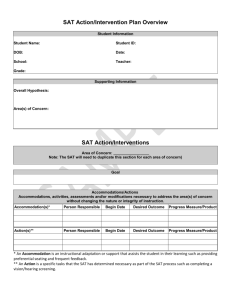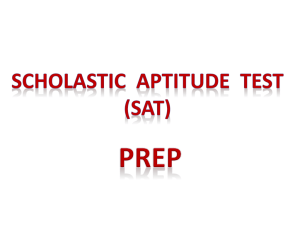SAT Examples v6 - Collier High School
advertisement
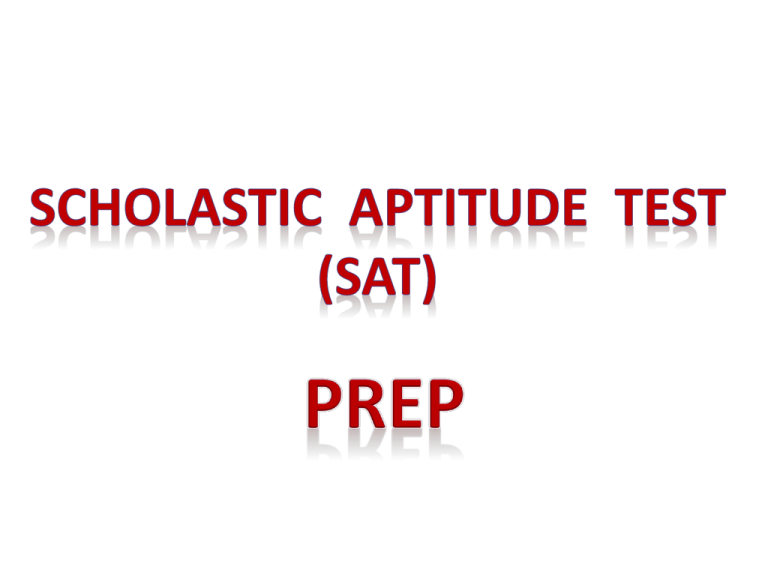
SAT 1. The figure shown is a square divided into two non-overlapping regions. What is the greatest number of non-overlapping regions that can be obtained by drawing any two additional straight lines ? (A) 4 (B) 5 (C) 6 (D) 7 (E) 8 (D) 7 This is a good example of “thinking outside the box.” The obvious choice is 6, which is wrong. The NOT so obvious but correct choice is D (7). SAT 2. A 50 foot wire runs from the roof of a building to the top of a 10 foot pole 14 feet from across the street. How much taller would the pole have to be if the street were 16 feet wider and the wire remained the same length ? (A) 2 feet (B) 8 feet 50 (C) 14 feet (D) 16 feet (E) 18 feet (E) 8 feet a a 50 x 14 a2 + 142 = 502 a2 + 196 = 2500 a2 = 2304 a = 48 10 x 14 10 16 (a – x) 2 + 302 = 502 (48 – x) 2 + 900 = 2500 (48 – x) 2 = 1600 48 – x = 40 8=x SAT 3. A dress is selling for $100 after a 20 percent discount. What was the original selling price? (A) $ 200 (B) $ 125 (C) $ 120 (D) $ 80 (E) $ 75 (B) $ 125 What do the given values really represent? This question really says that $100 is 80% of the original selling price. So, $ 100 = 80 % of x 100 = .8 x 125 = x SAT 4. If 3 parallel lines are cut by 3 non-parallel lines, what is the maximum number of intersections possible ? 1 (A) 9 2 (B) 10 3 4 5 (C) 11 (D) 12 6 (E) 9 13 7 10 8 12 11 (D) 12 The trick here is to make sure each non-parallel line intersects all 3 parallel lines and each other where there are NO COMMON intersections. SAT 5. If the average of x, y, and 80 is 6 more than the average of y, z, and 80, what is the value of x – z ? (A) 2 (B) 3 (C) 6 (D) 18 (E) It cannot be determined from the information given. x + y + 80 = y + z + 80 + 6 3 3 x + y + 80 = y + z + 80 + 18 x = z + 18 x – z = 18 (D) 18 SAT If x > 0, which of the following is equivalent to x3 ? I. 6. x+x½ II. (x½ ) 3 III. (x2) (x –½ ) (A) None (B) I and II only (C) I and III only (D) II and III only (E) I, II, and III (D) II and III only Choice option I. x + x ½ has no exponent rule for adding exponent expressions with like bases, which means choices B,C and E are NOT viable. Choice II works because x½ is the same as square root of x, which means A is not valid, leaving Choice D as the only possible choice. SAT 7. If (A) 5 (B) 7 5 = x – 2 , what is the value of (x – 2)2 ? (C) 5 (D) 9 (E) 25 If (C) 5 5 = x – 2 , then ( 55 )2 = (x – 2)2 5 = (x – 2)2 SAT 8. In the expression x2 + kx + 12, k is an integer and k < 0. Which of the following is a possible value of k ? (A) – 13 (B) – 12 (C) – 6 (D) 7 (E) It cannot be determined from the information given x2 + kx + 12 = (x – 1 ) ( x – 12 ) = x2 – 13x + 12 (A) – 13 SAT 9. If 2x – 3y = 5, what is the value of 4x2 – 12 xy + 9y2 ? (A) 5 (B) 5 (C) 12 (D) 25 (E) 100 D) 25 Since 2x – 3y = 5 and 4x2 – 12 xy + 9y2 = (2x – 3y)2 = 52 = 25 SAT 10. x (3 – 3 ) = x (x + 7 ) x (A) – 7 (B) – 1 (C) 1 (D) 3 (E) 7 (C) – 1 Since 3x – 3 = x (x + 7) Then, 0 = x2 + 4 x + 3 and 0 = (x + 3) (x + 1) Thus, x = – 3 or – 1




